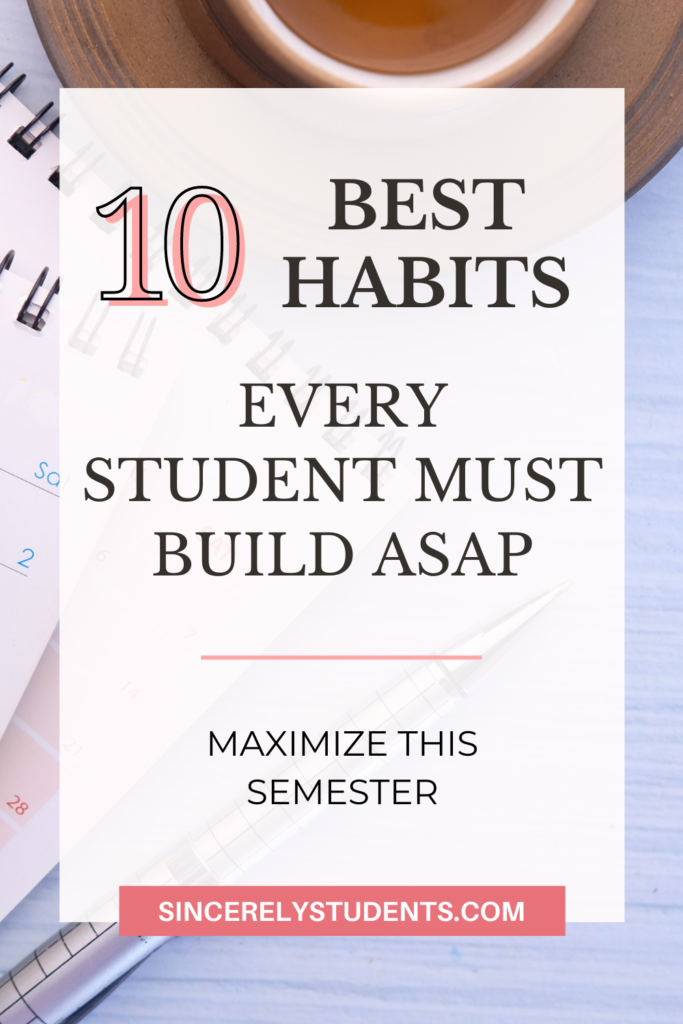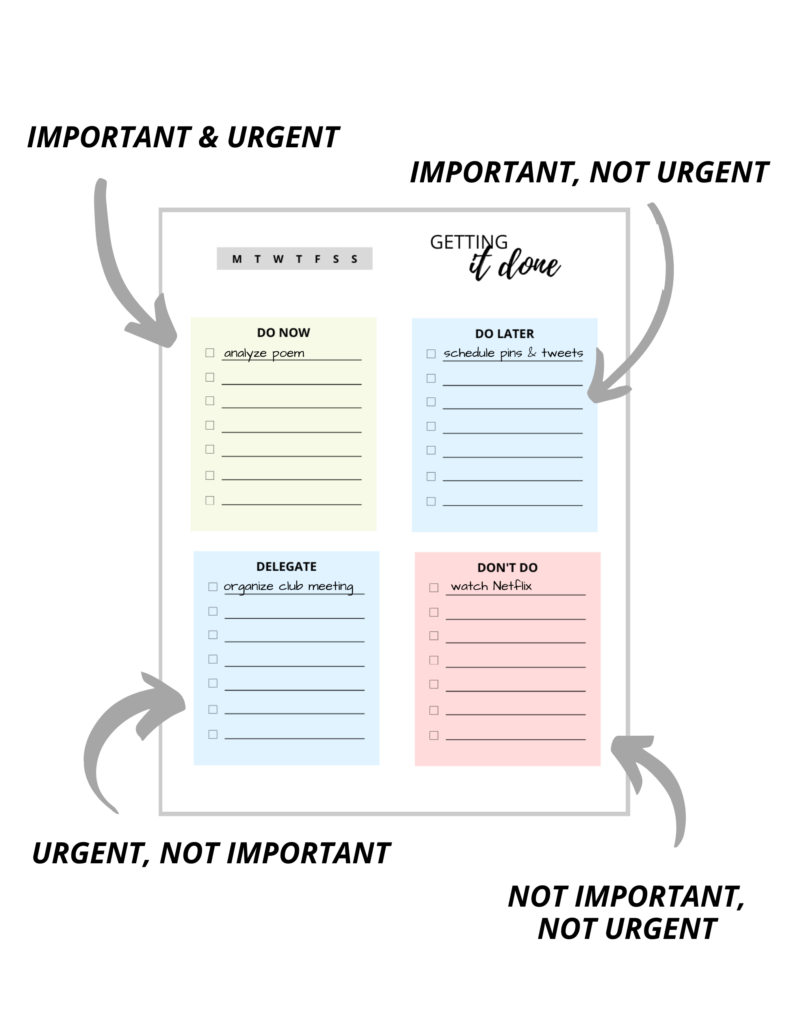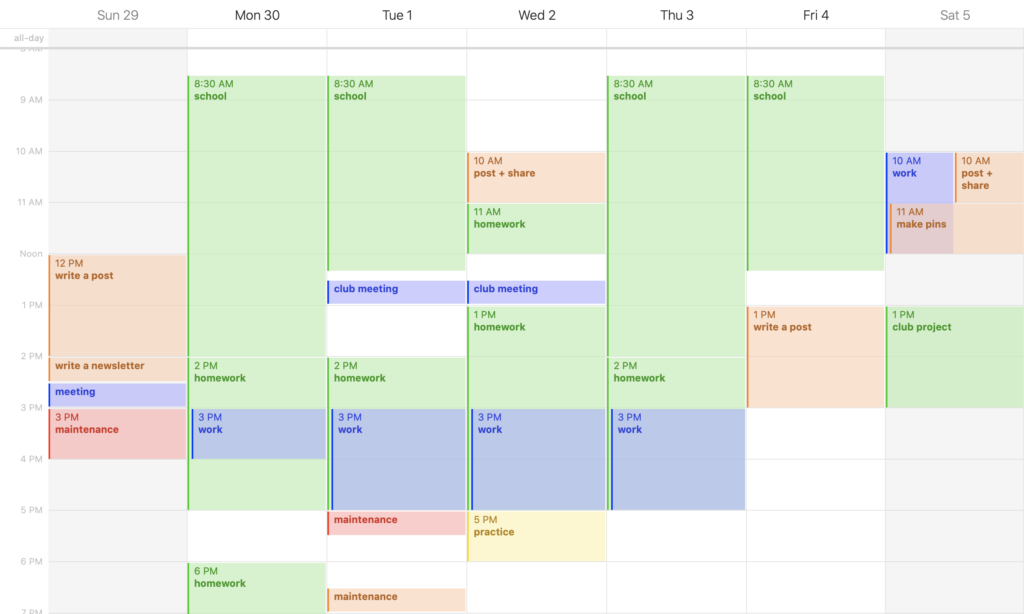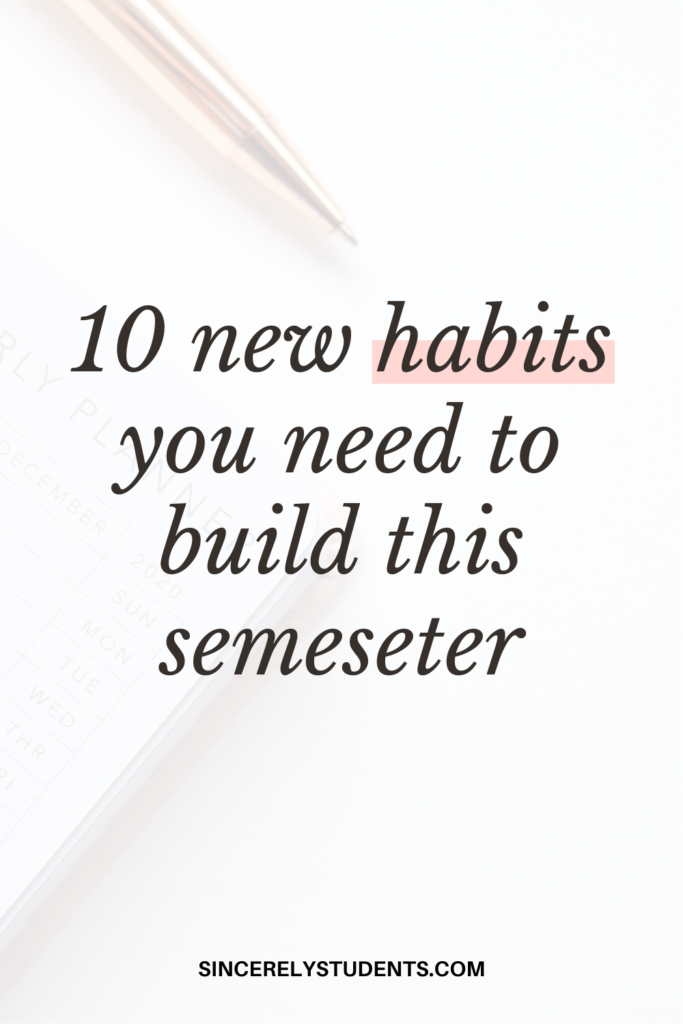If you’ve read another one of my posts, 7 Terrible Study Habits To Quit Immediately, then you know that there are bad and good habits one can build.
I’ve already taught you the 7 worst habits a student can have (in the post mentioned above); in this post, I’ll be going over the 10 best habits you should build this semester.
Every student (online students included!) should build these habits, and they’ll ensure productivity and effective studying. If you’re ready to become a top student in 2021, let’s get right into the post.

Improve your sleep schedule
Maintaining your physical health is crucial to ensuring success in other areas; without a healthy, functioning body and mind, you can’t really do anything else.
And one of the easiest ways to take care of yourself is to get enough sleep at night. Humans (especially young adults like you) need sleep to repair and replenish, and as a student who is constantly using brain power, you need at least 8 hours of sleep.
It can be hard to just flip your sleep schedule around and immediately start sleeping from 10 pm to 6 am. Trust me, I know. Instead, you have to build systems that help you prepare for the long-term maintenance of this habit.
In other words, create an ideal evening routine that helps you wind down at least 1 hour before your bedtime (the best time should be 11 pm). Then, follow this routine diligently until it becomes a habit that sticks.
If you struggle with building habits (and an evening routine) that stick, check out this workbook I made for you: The Complete Guide To Habit-Building. You’ll learn the foolproof 8-step process to habit-building, as well as templates and lists to track your habits and build new ones.
Keep your study space organized
If you have your own study space and your own desk, it’s incredibly important to keep your space organized; though a clean space may not necessarily guarantee a clean mind, it sure can help.
If you’ve got stacks of papers, open notebooks and textbooks, pens and pencils, and more items lying around, there will be little space for you to work. In addition, it’ll be a struggle to find the right supplies you need when you look for them.
Therefore, it’s crucial to get organized! Here are some ideas on how to organize your study space:
- Get rid of unnecessary items like old notebooks, dried pens, finished books…
- Get rid of distracting items like video games, your phone, snacks…
- Stack all your books on a shelf or somewhere else other than the surface of your desk.
- Put all your pens and pencils in organizers or a pencil case.
- Hide all small items in drawers or other storage places.
And here are a few of my favorite organizing tools:
- Pen organizer (this particular product includes 3 slanted caddies and 2 cups and comes in white or black)
- Accordion file organizer (great for storing and organizing papers)
- Floating wall shelves (to put books and small items on)
- File/folder stand (to put journals, books, folders, etc.)
Lastly, don’t forget to clean and organize your study space frequently! You can also spice it up every so often by switching up decorations and how you place things.
Make weekly plans
If you’re going from week to week without a plan or a goal in mind, you’re giving up precious time and productivity. Planning is crucial!
Having a weekly plan (and a system to create and execute that plan) will help you minimize the stress of juggling everything and chasing deadlines; it will organize and subsequently simplify your life, saving you so much time overall.
And truthfully, the weekly-planning process is simple. Here’s all you need to do:
- Create your weekly schedule.
Take note of important due dates, appointments, check-in dates for projects, etc, and write them down in your planner or organizer. Do not rely completely on your memory, because you never know when your mind will blank. Writing them down ensures that you don’t make plans that clash.
- List out the week’s goals and to-dos.
Create a master to-do list for the week that includes all the things you need to do, like homework assignments, project progress tasks, and other miscellaneous chores. If you’ve also set a goal for yourself, write that down as well (and preferably create some progress tasks for each day).
- Check-in with long-term goals.
If you’ve set some long-term goals (like yearly, quarterly, or monthly goals), check-in with your progress goals! As I mentioned in a previous post, The Ultimate Guide To Project Planning, creating smaller goals that build to your long-term goal will make it easier to complete it and track your progress.
- Be prepared and flexible with your plan.
Lastly, you simply have to be prepared to revise your plan during the week. Something might come up, and you’ll have to move around times. But even so, it’s absolutely necessary and beneficial to write your plans down somewhere, so don’t be hesitant to do so!
Write daily to-do lists
Daily to-do lists come almost hand-in-hand with my weekly plans. They– similar to the former– help me maintain structure during the day and stay accountable.
I usually plan my day in 2 ways: to-do lists and time blocks. I will talk about time blocking in the next section and focus on creating to-do lists, as it’s the first step and a slightly more intuitive planning technique.
In your daily to-do list, which I again recommend writing down on a physical piece of paper or planner, list out all the things you have to do that are not part of your daily routines and are actually important.
You can write this list in chronological order (based on time) or based on importance and urgency. Prioritizing (differentiating the most important tasks from the less important ones) will help you attack your to-do list in the most effective way. But how do you prioritize?
Check out this Eisenhower Matrix below:

You can use this structure to organize your tasks and thus prioritize them. If you’d like a physical copy of this matrix to use and organize all your tasks, you can download and print this exact template from my Freebie Library!
Time block busy days
Time blocking is essential for anyone who wishes to be super productive. And it’s so easy! Simply spread your to-do list over the time you’re awake and create blocks of time for each task. Don’t forget to schedule breaks as well!
You can do this on a physical planner or a digital calendar. Some like using a planner to get all the nitty-gritty details down, while others like a digital calendar for its ease of use.
I usually use my digital calendar, and my weekends up looking like this:

I believe that time blocking on a digital calendar is a lot easier, as you can edit blocks at any time. However, I suggest that you use a physical planner for to-do lists and weekly plans, as it’s easier to stay accountable for your tasks (and to not delete a task because you forgot to do it).
I really like this planner because it has literally everything you need to get planning and be productive.
Stop procrastinating
This is easier said than done, but lucky for you, I have an entire post called How To Stop Procrastinating In 7 Simple Steps. In that post, I’ve outlined the top tips you need to actually stop procrastinating. But here is a short overview:
- Use the right tools. Something like the Ultimate 3-in-1 Student Planner (made by yours truly) will help you perform all the next steps effectively.
- Plan ahead. Like I mentioned before, plan ahead! Use a planner, make weekly plans, and time block your days.
- Break it down. Don’t be intimidated by large to-do lists; instead, break large projects down into smaller tasks and take them on one at a time.
- Use time blocks. Again, time blocking is super helpful in staying accountable and organized throughout the day.
- Remove distractions. This applies especially to your phone and social media, which I will talk about in the coming sections of this post!
- Find your peak times. Determine when you’re most productive and least productive and plan your day accordingly.
- Keep a positive mindset. Keep your goals in mind and stay positive! And don’t forget to look back every once in a while to see how far you’ve come.
- Find a buddy. Having a productivity buddy can make it a lot more fun in building productivity.
Review every day
Reviewing your schoolwork helps you consolidate the information you learned but were unsure of, sort out confusing points, and remember the information better.
At the end of the day, take out your notes or a copy of the lecture slides/text, and go over each section, paying special attention to parts you were confused about (it can be helpful to circle these during the class).
You can review information in various ways, and I’ve listed some of my favorite methods below:
- Reading over notes carefully
- Rewrite parts of your notes
- Asking questions & answering them
- Test yourself
- Teach someone
YOU’LL LOVE THIS POST: 8 Daily Habits To Build To Become A Top Student
Limit social media time
Have you noticed that time seems to fly by when you’re scrolling through social media? As fun as it is, it will make you a master procrastinator and you’ll end up getting nothing done.
Therefore, you must limit your social media usage. You don’t need to delete the apps completely, but rather exercise self-control to avoid going on them as often.
One way to facilitate this is to turn off all social media notifications. When you receive a notification, you’re strongly inclined to open it immediately– because you feel like you’re obliged to respond. When you turn off notifications, it’ll become much easier to tell yourself not to go on it.
Another way is to literally set a timer on your phone to limit your usage of certain apps. In iPhones, you can go to Settings > Screen Time > App Limits > Add Limit to do so. You can try different things out to see what works best for you!
Participate in class
As of January 2021, all my classes are still online and via Zoom. And because of this, I’ve noticed myself slacking off sometimes, multitasking during class and not really paying attention.
Because of this, my learning suffered. I quickly realized that I’d have to spend extra time searching online to try to learn what my teacher taught during class. Obviously, I did not want to spend this extra time studying when I could be doing something else.
If this sounds like you, there’s an easy fix. Participate more in class! This will force you to pay attention and actively engage your brain with the information and the teacher.
In addition, being an active participant in class will leave a good impression on your teacher, and this could be very useful for future references, or just making a new friend (yup, with your teacher) in school!
Practice a proactive mindset
Lastly, I encourage you to practice a proactive mindset this semester. This means that you’re taking control of your life and learning, and not letting them control you.
This semester, try to actively seek out solutions to your problems (instead of giving up or relying on others to give you the answer), find the opportunities you’re waiting for (don’t just sit and wait, look for them!), and just do stuff yourself!
Oftentimes, only you know what you want, and only you can be the one to find it for yourself. So start shifting your mindset and being more proactive!
Conclusion
I hope this post was helpful and gave you an idea of how to be your best self this semester! With these 10 habits, you’ll be on your way to become a more productive person and a better student!
If you liked this post and would like to read more, here are a few I think you’d love:
- 9 Free Apps Every Online Student Needs In 2021
- 8 Daily Habits Of Highly Successful Students
- The Ultimate Guide To Studying From Home
